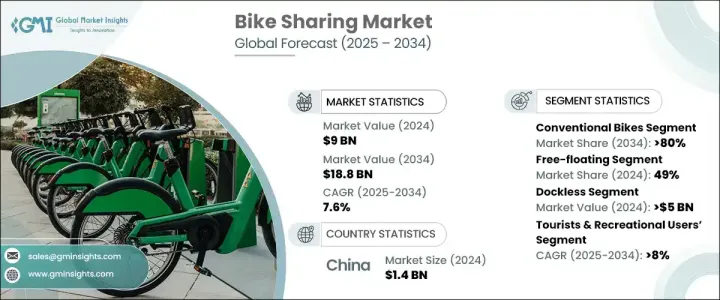
세계의 자전거 셰어링 시장은 2024년에 90억 달러에 이르렀고, 2025년부터 2034년까지 연평균 복합 성장률(CAGR) 7.6%를 나타낼 것으로 예측됩니다.
세계의 도시가 친환경 교통수단을 우선하는 가운데 비용대비 효과가 높고 지속가능한 도시모빌리티 솔루션에 대한 수요 증가가 시장 확대의 원동력이 되고 있습니다. 도시화가 가속됨에 따라 매일 통근이나 레저, 라스트원 마일의 이동에 쉐어 사이클을 이용하는 개인이 늘어나 업계의 성장에 박차를 가하고 있습니다.

디지털 결제 시스템과 앱 기반 예약 플랫폼의 진보로 사이클 공유 서비스는 이전보다 더 쉽게 사용할 수 있습니다. 이 기술의 원활한 통합은 특히 인구 밀도가 높은 대도시 지역의 보급률을 높이고 있습니다. 그리고, 시장 경쟁도 격화하고 있어, 플릿의 확대, 유지관리, 유저 익스피리언스의 향상에 대한 투자가 촉구되고 있습니다. 이와 같은 인프라 정비의 기회가 탄생하고 있습니다.이러한 대처는 증가하는 사이클리스트를 서포트할 뿐만 아니라, 안전성과 편리성을 향상시켜, 오토바이 셰어링을 종래의 교통 수단에 대신하는 실행 가능한 선택지로 하고 있습니다.
| 시장 범위 | |
|---|---|
| 시작 연도 | 2024년 |
| 예측 연도 | 2025-2034년 |
| 시작 금액 | 90억 달러 |
| 예측 금액 | 188억 달러 |
| CAGR | 7.6% |
시장은 자전거 유형별로 기존 자전거와 전기자전거로 구분되며 기존 자전거는 시장 점유율의 80%를 차지합니다. 전기자전거와는 달리 기존 자전거는 저예산으로 대여료를 유지하면서 플릿을 확대하고 싶은 사업자에게 있어서 비용 효율적인 솔루션입니다.
공유 시스템은 프리 플로팅 유형과 스테이션 유형으로 분류되며, 2024년에는 프리 플로팅 유형이 시장의 49%를 차지했습니다. 특히 라스트원 마일 연결의 어려움을 겪고 있는 도시에서는 모바일 앱에서 자전거의 위치를 확인하고 잠금을 해제할 수 있는 편리성이 채용을 크게 증가시키고 있습니다.
중국의 자전거 셰어링 시장은 2024년에 14억 달러를 창출해 급속한 도시화와 친환경 교통에 대한 정부의 강력한 지원을 통해 그 아성을 유지했습니다. 당국은 혼잡과 공해를 완화하는 지속 가능한 통근 수단으로서의 자전거 이용을 강화하기 위해 도시 교통망에 공유 자전거를 적극적으로 통합하고 있습니다.
The Global Bike Sharing Market reached USD 9 billion in 2024 and is projected to grow at a CAGR of 7.6% between 2025 and 2034. The rising demand for cost-effective and sustainable urban mobility solutions is driving market expansion as cities worldwide prioritize eco-friendly transportation. Governments and city planners are actively encouraging bike-sharing programs to address traffic congestion and curb carbon emissions. As urbanization accelerates, more individuals are embracing shared bicycles for daily commuting, leisure, and last-mile connectivity, fueling industry growth.

Advancements in digital payment systems and app-based booking platforms have made bike-sharing services more accessible than ever. With just a few taps on a smartphone, users can locate, unlock, and pay for bike rentals instantly. This seamless integration of technology is boosting adoption rates, particularly in densely populated metropolitan areas. The growing presence of tech-driven service providers is also intensifying market competition, prompting investments in fleet expansion, maintenance, and user experience enhancements. Additionally, partnerships between bike-sharing companies and municipal authorities are creating opportunities for infrastructure development, such as dedicated cycling lanes and docking stations. These initiatives not only support the rising number of cyclists but also enhance safety and convenience, making bike-sharing a viable alternative to traditional transit options.
| Market Scope | |
|---|---|
| Start Year | 2024 |
| Forecast Year | 2025-2034 |
| Start Value | $9 Billion |
| Forecast Value | $18.8 Billion |
| CAGR | 7.6% |
The market is segmented by bike type into conventional bicycles and e-bikes, with conventional bicycles accounting for 80% of the market share. This segment is expected to generate USD 14 billion by 2034 as traditional bicycles continue to dominate due to their affordability and minimal maintenance requirements. Unlike e-bikes, which require charging stations and battery replacements, conventional bicycles are a cost-effective solution for operators looking to expand their fleets while maintaining budget-friendly rental fees. Their accessibility appeals to a broad user base, from daily commuters seeking an economical travel option to leisure riders exploring urban landscapes.
The sharing system is categorized into free-floating and station-based models, with free-floating bike-sharing capturing 49% of the market in 2024. This model offers greater flexibility, allowing users to pick up and drop off bikes anywhere within a designated service area rather than returning them to fixed docking stations. The convenience of locating and unlocking a bike via a mobile app has significantly increased adoption, especially in cities struggling with last-mile connectivity challenges. The elimination of fixed stations also reduces operational costs for service providers, enabling them to expand their coverage across larger urban areas.
China bike sharing market generated USD 1.4 billion in 2024, maintaining its stronghold due to rapid urbanization and robust government support for eco-friendly transportation. The country's extensive infrastructure and widespread adoption of digital payment solutions have made bike rentals seamless through mobile applications. Authorities are actively integrating shared bicycles into urban transportation networks, reinforcing cycling as a sustainable commuting option to alleviate congestion and pollution. These strategic initiatives continue to strengthen China's leadership in the global bike-sharing industry.